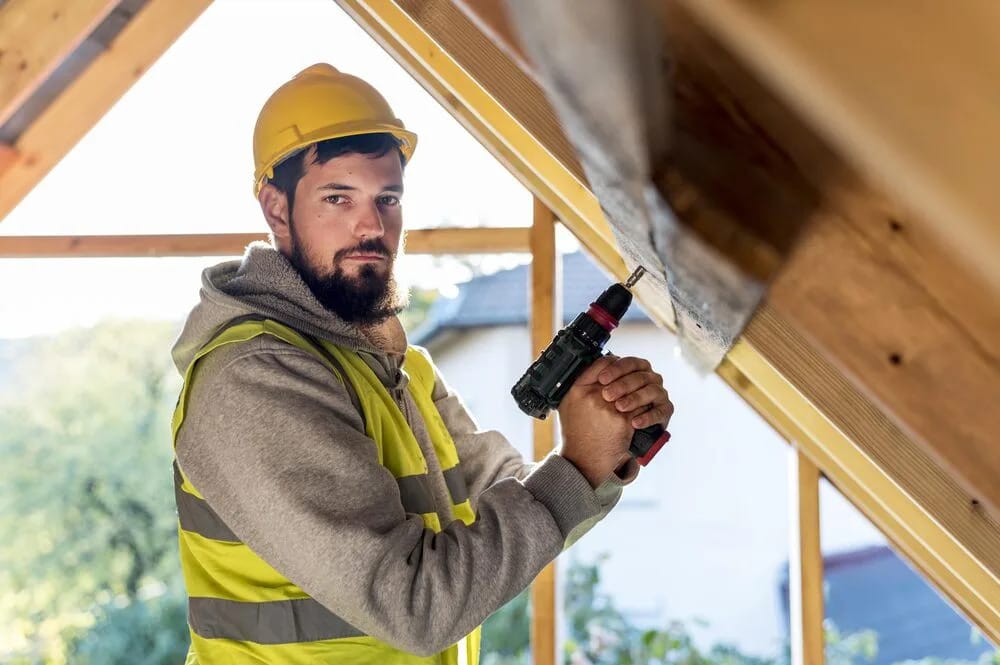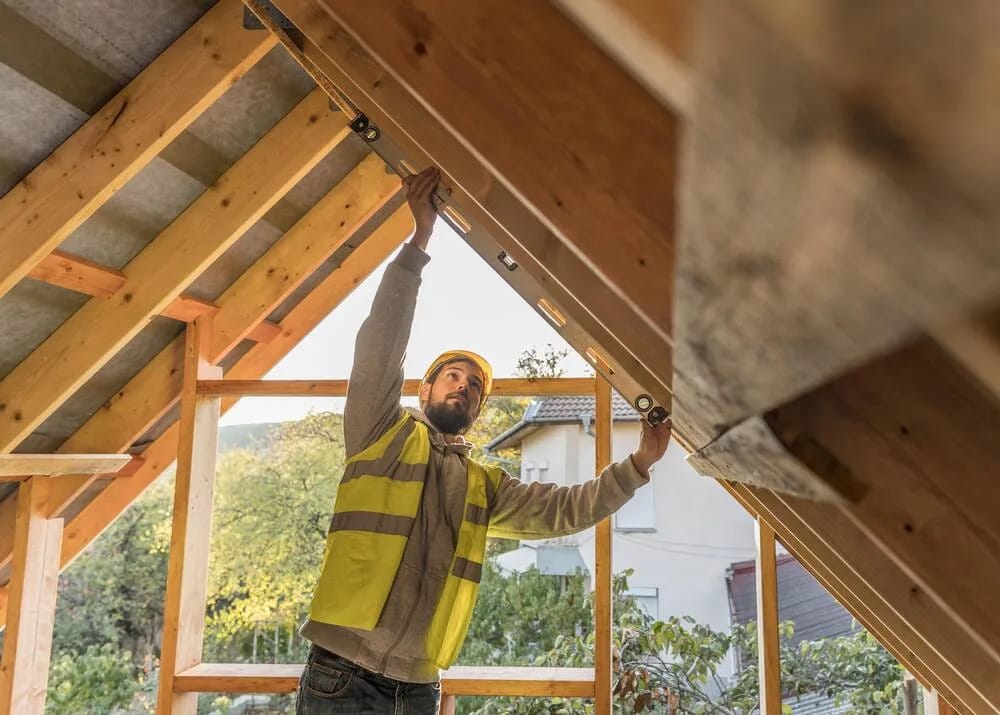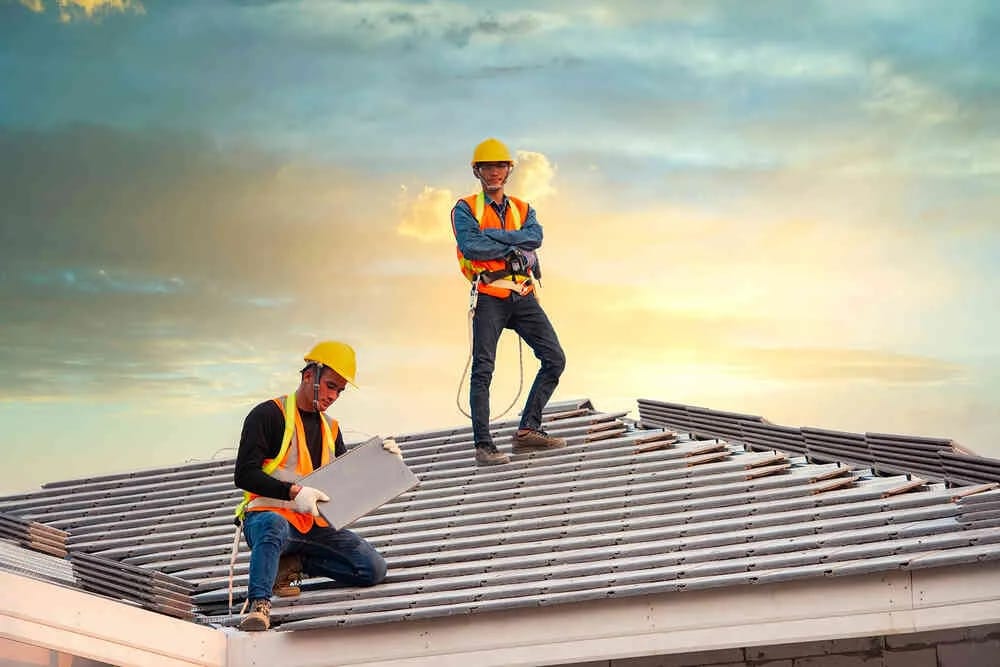- Free Estimates

Storms can leave roofs in disrepair, exposing homes and businesses to leaks, structural issues, and further damage. While some may consider handling minor fixes on their own, hiring a professional roofing contractor ensures that repairs are done properly, safely, and in compliance with industry standards. Severe storms have led to substantial damage across Connecticut. For instance, a storm resulted in approximately 800 homes and businesses reporting damage, prompting the state to seek federal aid for recovery efforts. Storm damage can range from missing shingles to structural deterioration, making professional roofing services crucial for protecting property investments.
Here are the five key reasons to hire a roofing contractor after storm damage.
Key Takeaways✔ Storms cause both visible and hidden roof issues. A roofing contractor uses specialized tools to detect moisture penetration, structural weakening, and mold growth before they escalate. ✔ DIY roof repair can be dangerous and ineffective. Professionals follow safety regulations, use high-quality materials, and install roofing components correctly to prevent further damage. ✔ Filing an insurance claim can be complex. A roofing contractor provides documentation, repair estimates, and negotiates with adjusters to ensure homeowners get the coverage they deserve. ✔ Professional roofing services reinforce weak spots, improve drainage, and offer maintenance plans to protect against future storms, extending the roof’s lifespan. ✔ Hiring a professional for roof replacement or repairs prevents costly mistakes, ensures warranty protection, and speeds up the repair process, reducing downtime for homeowners and businesses. |
After a storm, a thorough roof inspection is necessary to assess the extent of damage. While some issues may be immediately noticeable, others can be hidden beneath the surface, worsening over time and leading to expensive repairs. It is important to recognize these signs early to avoid further deterioration and potential safety risks.
One of the most obvious signs of storm damage is missing or loose shingles. High winds can easily rip shingles off a roof, exposing the underlayment and decking to rain, debris, and harsh environmental conditions. Even if shingles remain intact, they may become loosened or shifted, creating gaps where water can seep through. In some cases, the sealant strip between shingles can also weaken, reducing the roof’s ability to protect against future storms.
🔹 Why It Matters: Missing shingles leave the roof vulnerable to leaks and structural weakening. If not repaired quickly, exposed areas can deteriorate and lead to roof replacement sooner than expected.
Leaks may not be immediately visible, but they often manifest as water stains on ceilings and walls. Even small leaks can cause significant structural damage over time, leading to mold growth, rotting wood, and weakened insulation. Heavy rains and wind-driven moisture can penetrate the smallest openings, allowing water to travel far from the original point of entry before becoming noticeable inside the home.
🔹 Why It Matters: Leaks left unaddressed can lead to mold infestations, damage to drywall, and even electrical hazards. Homeowners should check for discoloration on ceilings, peeling paint, or damp odors, as these can be indicators of water infiltration.
Hailstorms are particularly destructive to roofs, especially those made of asphalt shingles, metal, or tile. Hailstones can vary in size, from small pellets to large chunks, and they hit the roof with enough force to cause significant damage. Connecticut experiences significant storm activity, including hail and high winds. In 2024, the state reported 84 severe wind incidents and 14 severe hail events, with hailstones measuring over an inch in diameter. These intense storms can dent metal panels, crack shingles, and strip away protective granules, reducing the roof’s lifespan. Common effects of hail damage include:
🔹 Why It Matters: Even if the damage is not immediately visible, hail can weaken roofing materials and increase the risk of roof repair or roof replacement in the future. A professional roofing contractor can perform a close inspection to assess the severity of hail damage.
Flying debris, such as tree branches, broken glass, or even outdoor furniture, can cause serious damage to a roof during a storm. Impact from large debris can puncture the roof, leaving holes that allow water and pests to enter. Even small debris can scrape or weaken roofing materials, making them more susceptible to leaks. Signs of impact damage include:
🔹 Why It Matters: Even minor impact damage can compromise the integrity of the roof. Punctures can cause interior water damage, and weakened areas are more likely to fail in future storms. Addressing damage immediately with professional roofing services helps prevent costly repairs.
Flashing is a crucial component of any roofing system, as it seals vulnerable areas such as chimneys, vents, skylights, and valleys. Strong winds and heavy rain can loosen or detach flashing, allowing water to penetrate gaps and seep into the home. Damaged or missing flashing is a major cause of water leaks and should be inspected after any severe storm.
Gutters and downspouts also play a critical role in protecting a roof by channeling rainwater away from the structure. Storms can clog gutters with leaves, dirt, and debris, leading to water backup and overflow. If water cannot drain properly, it can pool on the roof, causing deterioration and leaks.
Signs of flashing or gutter damage include:
🔹 Why It Matters: Faulty flashing and gutter issues can lead to extensive water damage, requiring significant roof repair. Regular maintenance and inspections after storms can prevent these problems from escalating.
Not all storm damage is immediately visible. While missing shingles or debris impact are easy to spot, underlying issues often go unnoticed without a professional inspection. A roofing contractor has the experience, tools, and knowledge to detect hidden problems before they escalate into costly repairs.
A roofing contractor uses specialized tools such as infrared scanners, moisture meters, and drone technology to assess the roof’s condition. These advanced techniques allow them to identify weak spots and areas where water may have infiltrated, ensuring that no damage goes unnoticed.

Attempting DIY roof repair after a storm can be dangerous and may lead to further damage if done incorrectly. Climbing onto a compromised roof increases the risk of injury, and without the right tools or expertise, repairs may not hold up against future storms.
A roofing contractor follows strict safety protocols and local building codes to guarantee quality repairs. They also use high-quality materials that enhance the roof’s durability.
Filing an insurance claim after storm damage can be confusing and time-consuming. Without proper documentation, homeowners risk receiving inadequate compensation or having their claims denied altogether.
A roofing contractor provides:
✔ Comprehensive damage assessments: A detailed report of storm-related damage with photographic evidence.
✔ Accurate repair estimates: A breakdown of the costs involved in roof repair or roof replacement.
✔ Insurance negotiation support: Experienced contractors work with adjusters to ensure fair compensation.
A strong, well-maintained roof is essential for protecting a home or business from future storms. Simply patching up visible damage may not be enough to prevent further problems, which is why professional repairs are critical.
✔ Reinforced installation techniques: Roofing professionals use advanced methods to strengthen vulnerable areas.
✔ Improved drainage solutions: Proper gutter and downspout installation prevent water buildup and leaks.
✔ Routine inspections and maintenance plans: Scheduled checkups help detect issues early, reducing repair costs.
Roofs that receive only temporary or patchwork fixes are more likely to fail under extreme weather conditions. A roofing contractor ensures that repairs are built to last, minimizing the need for emergency fixes after every storm.
While DIY fixes may seem like a cost-saving solution, they often lead to more expensive repairs in the long run. Incorrectly installed shingles missed leaks, and inadequate sealing can result in ongoing roof repair costs that add up over time.

Selecting a roofing contractor after storm damage is one of the most important decisions homeowners and businesses can make. A poorly chosen contractor can lead to subpar repairs, unnecessary expenses, and even safety hazards. Here are key factors to consider when selecting a professional roofing contractor for roof repair, roof replacement, or commercial roofing services.
Hiring a licensed and insured roofing contractor protects property owners from potential financial and legal risks. A legitimate professional should have:
✅ State or local licensing: Roofing contractors must meet specific requirements to operate legally, ensuring they follow industry standards.
✅ General liability insurance: Covers any property damage caused during the project.
✅ Workers’ compensation insurance: Protects homeowners from liability if a worker is injured on the job.
A contractor’s reputation speaks volumes about their work quality and reliability. Checking customer feedback provides insight into past projects and overall customer satisfaction.
✔ Google Reviews: Offers a mix of positive and negative experiences from previous clients.
✔ Better Business Bureau (BBB): Rates contractors based on complaint history and business practices.
✔ Angi (formerly Angie’s List), Yelp, and HomeAdvisor: Feature detailed customer feedback.
🔹 Consistent positive feedback: Multiple satisfied customers indicate reliable service.
🔹 Contractor response to complaints: Professional contractors address issues and strive for customer satisfaction.
🔹 Before-and-after project photos: Helps verify the quality of previous roof replacement or roof repair work.
Not all roofing contractors specialize in storm-related damage. A contractor experienced in roof repair and roof replacement after extreme weather will understand the unique challenges that come with high winds, hail, and heavy rain.
✔ Familiarity with various roofing materials (asphalt shingles, metal, slate, tile, and commercial flat roofs).
✔ Knowledge of local building codes related to weather-resistant roofing.
✔ Proven track record of helping homeowners with insurance claims.
Before committing to a roofing contractor, property owners should obtain a written estimate outlining the project’s specifics. A professional estimate provides clarity on costs, materials, and the timeline.
📌 Scope of work: Clearly defines what will be repaired or replaced.
📌 Material costs: Specifies the brand, type, and quality of materials to be used.
📌 Labor fees: Breaks down costs associated with skilled labor.
📌 Timeline for completion: Provides a realistic schedule for the project.
📌 Payment terms: Outlines deposit requirements, milestone payments, and final payments.
🚩 Vague descriptions: Contractors should be specific about materials, costs, and work to be done.
🚩 Significantly lower pricing: A contractor offering prices far below competitors may be cutting corners.
🚩 No written agreement: Verbal promises are unreliable and legally unenforceable.
A reputable roofing contractor should provide warranties for both materials and workmanship, giving homeowners and businesses peace of mind.
✔ Manufacturer’s Warranty: Covers defects in roofing materials. Length varies depending on the material used (e.g., 25-50 years for asphalt shingles, lifetime for metal roofing).
✔ Workmanship Warranty: Covers errors in installation and labor. Most professional contractors offer at least a 5-10 years workmanship guarantee.
✔ Extended Warranties: Some contractors provide additional coverage for an extra fee.
Look for visible signs such as missing or damaged shingles, leaks, or sagging areas. Some damage may not be obvious, so a professional roofing contractor can perform an inspection to assess the full extent. If the damage is severe or affects the roof’s structural integrity, a roof replacement may be necessary.
The contract should clearly outline the scope of work, materials used, labor costs, and project timeline. It should also include payment terms, warranty details, and insurance coverage to protect both parties. A well-documented contract ensures transparency and prevents disputes during the roof repair or roof replacement process.
Minor roof repairs can take a few hours, while extensive storm damage or a full roof replacement may require several days. The timeline depends on factors such as roof size, material availability, weather conditions, and contractor availability. A professional roofing contractor will provide an estimated completion time before starting the project.
In some cases, a second layer of shingles can be installed over the existing roof, but this depends on local building codes and the condition of the current roof. If there are structural issues, trapped moisture, or too many existing layers, a complete tear-off is required. A roofing contractor can inspect the roof and determine the best approach for long-term durability.
Regular roof inspections, proper attic ventilation, and reinforced materials can help increase storm resistance. Installing impact-resistant shingles, securing loose flashing, and maintaining gutters improve durability. A roofing contractor can recommend upgrades and maintenance strategies to help protect against future storms.
Storm damage can leave your roof vulnerable to leaks and costly repairs, making it essential to hire a trusted professional. Roofing Contractor of Southbury provides expert roof repair and roof replacement services to homeowners and businesses in Southbury, CT. Whether your roof has missing shingles, leaks, or structural damage, their team ensures high-quality, long-lasting solutions. If you’re looking for reliable roofing services in Southbury, CT, Roofing Contractor of Southbury is the name you can trust. Our licensed and insured experts will inspect your roof, assist with insurance claims, and restore your home’s protection.
Call us now to schedule your free consultation and keep your home in Southbury, CT safe and secure!